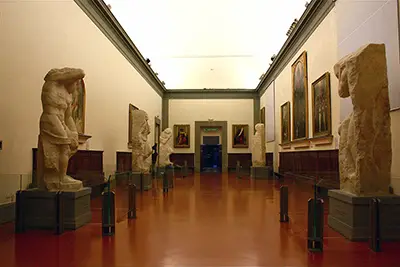The Awakening Slave, The Young Slave, The Bearded Slave and The Atlas (or Bound) are all incomplete but still offer an important contribution from this old master. They all have most of their anatomies constructed, but remain attached to the original stone, giving them something of an organic feel. The artist would often hand over to others to finish off his work, such were the commitments that he took on around the country as his reputation continued to attract more and more patrons all the time. To see such stunning items in person, but with elements of the original form in tact, we can really get a good understand of how Michelangelo would have put these together, with individual marks of the chisel still on show to those able to get up close enough to see.
Some art historians have claimed that these pieces were deliberately left seemingly incomplete because what was left would symbolise the struggle of men to escape their surroundings. That said, the four are not at equal stages themselves, with Young Slave being close to completion, whilst the anatomy of The Atlas was still very much waiting to be formed, with just a suggestion of a figure in that piece. Michelangelo liked to leave some of the latter tasks such as polishing to his assistants, though it is important to remember that many of those who worked alongside him would actually come out of his shadow eventually and have significant careers in their own right. The slaves, or prisoners as they are sometimes known, were supposed to number sixteen or twenty in total, but the initial four were the only ones completed in the end.
Many of Michelangelo's projects would either be unfinished or simply restructured to a more modest nature due to the constant distractions that he had in his professional life. Contracts would be signed and then later amended or even annulled as sometimes he would be elsewhere in the country, with his assistants unable to complete major work on their own. This behaviour allowed the master to attract new projects all the time, and never be to bogged down in a single project, unless of course he felt it to be high profile enough that it was fine to be so. Michelangelo became known as famously hard to deal with, but his undoubted talent and innovative reputation ensured that even the most powerful of figures within Italy would be willing to deal with him.


